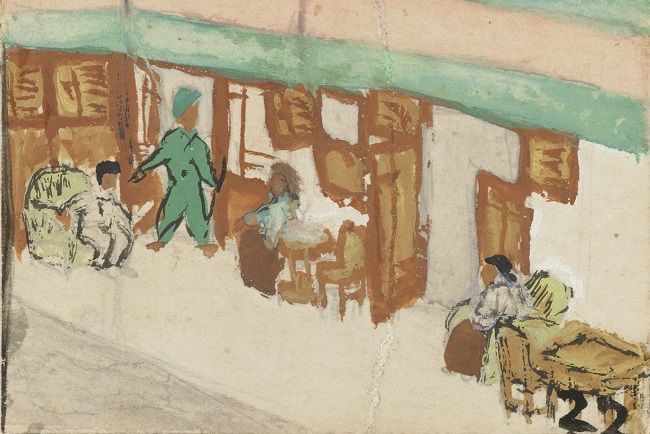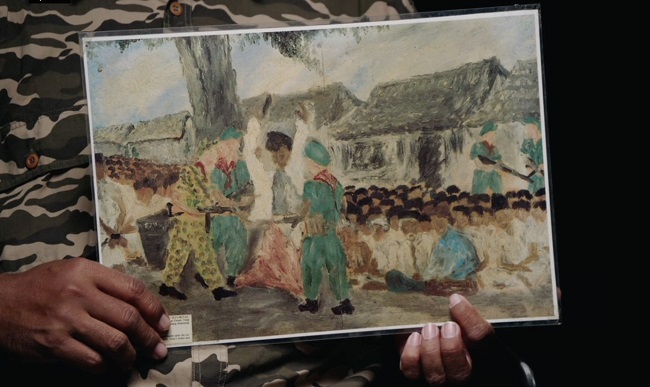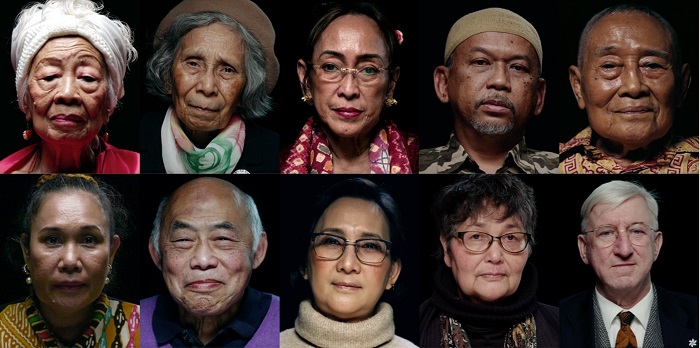Research and art collective Beyond Walls produced a series of film portraits of descendants of the Indonesian revolution for the exhibition Revolusi! Why was it important to highlight these personal stories?
Beyond Walls: Suzanne Rastovac, Armando Ello, Jeremy Flohr and Glenda Pattipeilohy
Amsterdam-based research and art collective Beyond Walls was invited by Rijksmuseum to direct and produce a series of film portraits of descendants of the Indonesian revolution to be included in its exhibition Revolusi! (11 February – 6 June 2022). The museum’s exhibition focused on the period between two important historical events: Sukarno’s declaration of Indonesian independence on 17 August 1945, and his return to the country after the Dutch formalised independence through the ‘transfer’ of sovereignty on 27 December 1949. It highlighted the spirit of the revolution and struggle for independence beyond violence alone. Revolusi! explored the larger themes of nationalism, anti-colonialism, war, diplomacy and propaganda. According to the Rijksmuseum, Revolusi! was about the Indonesian struggle for independence seen through the eyes of people who experienced it. More than 20 personal stories were highlighted, showing ‘how the ideal of a free Indonesia is fervently pursued; how it is fought over, how it is negotiated, how it is propagated and how the revolution determines human lives’, explains the exhibition website.
Beyond Walls was invited to work with the curatorial team to select ten of these stories based around a selection of objects, and to direct and produce film portraits. An equal balance of ‘Indonesian’ and ‘Dutch’-centred perspectives was essential. Initially intended for the online exhibition page, after viewing the portraits the museum decided to make it part of the physical exhibition. The film portraits, which Beyond Walls titled Afterlives of Revolution, were viewed by many people. When the exhibition closed in June 2022, 120,000 visitors watched these personal stories in the Rijksmuseum and the films hadmore than half a million unique viewers online.
The power of stories
There is great value in personal stories. Alongside historical archives, they can be sites of resistance. They can evoke emotional engagement from the spectator and make history tangible and accessible. To enhance emotional engagement in our film portraits, we let the storyteller look straight into the camera lens while talking. The eye-to-eye contact created a connection with the storyteller. More empathy towards the storyteller and their story can lead to a more open view on the impact of history. In the context of the exhibition, the film portraits of people who were connected to this important period added the extra dimension to static objects on display and offered insight into how events like Revolusi shaped people’s lives, across time and generations.
Afterlives of Revolution features the stories of ten people with very different personal relationships to the revolution. They are the sons and daughters of the people whose objects and art works were featured in the exhibition: Martha Anthony-Akihary, daughter of Petrus Akihary, a Moluccan soldier of the Royal Dutch-Indies Army (KNIL); Kwee Tjoe Houw, the son of Letty Kwee, a Chinese resident of Jakarta, who had to flee to the Netherlands; Sukmawati Sukarno, the third daughter of the first president Sukarno; Tjokorda Gde Esa Kresna Pudak, son of the Balinese freedom fighter Tjokorda Rai Pudak; Kurniawan Adigunarso, son of painter Mohammad Toha Adimidjojo; Pier Terwen, son of Jeanne van Leur-de Loos, a Dutch resident who was interned in a Japanese camp; Evlina Suzanna Sinuraya, daughter of Sumatran freedom fighter Eben Hezer Sinuraya; Merapi Obermayer, daughter of Julia Nelisse, who lived in a leper colony during the revolution; Sena Meaya Ngantung, daughter of Menadonese painter Henk Ngantung; and Kartika Affandi, daughter of nationalist painter Affandi. As these stories illustrate, the Revolution did not necessarily end for all when the Dutch left. Hence the layered title Afterlives of Revolution.
The ten stories were intended to provide a glimpse of the diversity of lived experiences. In producing the portraits, it was important to centralise different voices and perspectives from people who live in the Netherlands as well as in Indonesia. For us it was essential to not only film people living in Indonesia, but also to work with people from Indonesia. Working with people of the country concerned, brings us beyond our own situated gaze. That is also why co-creation is part of our practice. We partnered with Indonesian documentary maker Lexy Rambadeta and his team with whom we had worked in the past. In the Netherlands we also collaborated with Indonesian scholars, amongst them the exhibition curators Bonnie Triyana and Amir Sidharta, and Feba Sukmana, who helped us in the precise translation process.
Stories behind the stories
The well-received portraits led to a lot of moving messages. The film hall, situated in the closing section of the exhibition, was filled with visitors every day. To us it underlines the power of the stories and the strength of the human experience during historic events. They can also reveal facts of history that might be ‘forgotten’ or erased in the grand narrative.
Roots of Revolution
In a film series surrounding the Indonesian revolution, the story of Sukarno is one of the stories that could not be missed. With the help of the team in Indonesia we interviewed Sukarno’s daughter Ibu Sukmawati Sukarno, who lives in Bali and feels a close connection to her Balinese ancestry. In the interview, she talks about her relationship with her father. Her father had a vision, and she feels she is a child of the revolution – a revolution that was also deeply connected to their Balinese roots.
Sukarno’s mother was Balinese and taught her son the history of the Puputan related practice of mass ritual suicide facing defeat in battle. From the mother’s side of Sukarno, the family had witnessed a Puputan (Sukmawati did not mention whether this was the Puputan in Badung in 1906, or the ensuing one in Klungkung in 1908), in which an anti-colonial procession led by Balinese royals ended in a massacre by Dutch gunfire as well as ritual suicide. The Revolusi’s slogan ‘merdeka atau mati’ – ‘independence or death’ – was not just a protest slogan or a threat to the Dutch oppressors. It was rooted in the spirit of the Puputan and thus linked to Balinese culture as well. While filming the interview, Lexy was startled by this new insight he never heard of before. The remarkable story of Sukmawati added an extra layer to the exhibition.
The man in the blue surjan
Another interesting story behind the story was that of Mohammad Toha Adimidjojo (1937–2006), a young boy at the time of Revolusi, who crafted his painting skills under the famous tutor Dullah. Toha painted scenes of war, including arrests and violence committed by Dutch troops in his besieged and occupied home city of Yogyakarta. His famous small watercolours were part of the exhibition. When we proposed this story to be included in our series, we were told that they were unable to find any members of the Toha family. We were convinced that Toha’s relatives would be somewhere, but that it would probably take a longer search. Indeed, thanks to Lexy and his team we finally found Toha’s son Kurniawan Adigunarso who was willing to be interviewed about his father.
Kurniawan added a layer to the moving story about his father witnessing Dutch troops marching into Yogyakarta, in December 1948. Toha’s paintings did portray the Revolusi through the eyes of a young Javanese boy. But there was a hidden family story as well, Kurniawan shared.

During the interview, Lexy asked Kurniawan about the paintings, one of which pictured Dutch soldiers searching Toha’s house looking for his brother who became a guerrilla. 'Kurniawan said that, although he is aware of this story, his dad always mentioned the arrest of his grandfather, Toha’s father, instead. In the painting it is the man wearing a blue surjan. A traditional Javanese attire for men.'
According to Kurniawan, Toha made at least four paintings where Toha’s father appears in the same blue surjan. Put together in order, they tell the story of Toha’s father’s arrest. Until now Toha’s paintings are merely framed in the context of the Revolution and the atrocity Dutch troops committed against Indonesian forces and civilians. But in this case, it is interesting to discover a hidden personal family story as well. Kurniawan said that when his dad sold the paintings to the Rijksmuseum, he kept one painting about his grandpa’s arrest for the family. This original painting is still proudly kept at the family house.

The personal stories of Sukmawati and Kurniawan, as well as all of the portraits that were shot in Indonesia, are the result of co-creating between the Netherlands and Indonesia. Together we determined which parts might interest a diverse public, and enable people to connect with stories and perspectives they might not be aware of. These stories offered insights for both countries, that can help understand our entangled histories through a variety of lenses.
Diaspora
People from the diaspora living in the Netherlands were an important part of the series as well. In a country of 17.5 million people there are now approximately 2 million people with historical and family ties with the country we call Indonesia. The Netherlands and Indonesia are also connected through the diverse diaspora with Papuan, Malukan, Peranakan Chinese, Indo-European heritage, and the specific historical trajectories they represent. These stories are essential for understanding how colonialism played out in the aftermath of the revolution. This diaspora includes, for example, people from different parts of the Maluku islands, amongst them many soldiers who worked for the Dutch colonial army and faced many dilemmas.
A case in point is the moving story shared by Ibu Martha Anthony-Akihary whose father worked for the KNIL and faced challenges in both Indonesia and the Netherlands after the war. She tells how her father, after arriving in the Netherlands, made fishing nets for an envisioned future in Ambon, Maluku. But it turned out differently. She concludes with the message from her father that she always remembers: ‘Look ahead, make something of your life. Stop sulking, just go for it.’ Not only was it important to highlight her own memories of Revolusi, and the stories of resilience, but also the continuing impact in the aftermath of the revolution.
Afterlives
Stories of afterlives are not only about objects, history, or memory. They are also about identity and power, including the tension between the personal and national identity. Through national history a top-down identity is forced upon people by means of a dominant narrative that determines who belongs and who doesn’t. History then serves the purpose of the nation-state because ‘to form one story that becomes history, you have to erase many others that don’t match the grand narrative’, as Tamara Soukotta put it during a Beyond Walls public program on Revolusi Indonesia: Freedom and Resistance, on 16 February 2022. What if people cannot relate to the general story being told?
In the abovementioned public program, we zoomed in to focus on stories of Bali, Maluku and Papua, highlighting the impact of Revolusi and how it relates to the grand narrative. Historian Ligia Giay stated in her column for the program that the revolution period ‘is sensitive and loaded with meaning for people in the Netherlands and Indonesia, but very pointedly not among Papuans.’ She elaborated, ‘I am a Papuan who studies history and I am still trying to figure out why this period means so little to me emotionally.’ Her connection to 1945-1949 does not have roots in the events itself, she continued. ‘It is through current circumstances in Papua that I understand what it feels like to be immensely unsatisfied with a daily life filled with violence, injustice and impunity.’
On the last day of the exhibition, people from Papua, Aceh and Moluccan diaspora communities in the Netherlands and those in solidarity with them, protested in front of the Rijksmuseum. When visiting the exhibition, they were confronted by the lack of representation which they regarded as a form of erasure. The motivations behind the protest in the Netherlands are not isolated from the bigger story on oppression and injustice mentioned by Ligia Giay.
These examples, amongst many more, illustrate how a historically demarcated, nationalistic framework – whether Dutch or Indonesian – can perpetuate a dominant narrative that keep ‘uncomfortable’ stories at bay. In writing this, we also acknowledge the discomfort of our own positionality. Is speaking out on events that take place in present-day Indonesia from our positionality not a form of neo-colonial whataboutism? How could a collective that is situated in the Netherlands highlight these stories related to a sovereign country it formerly colonised? Indeed, it is important to acknowledge the different positionalities and trajectories. But addressing these afterlives doesn’t immediately mean ignoring the historical importance of the Revolusi. The story is, however, incomplete when we stick to a strict binary Dutch or Indonesian framework. It means that one cannot cherry pick history and its afterlives based on a single narrative that rules out the ‘inconvenient’ parts that don’t seem to fit in.
Decolonisation and decoloniality
To us, highlighting the afterlives also means positioning history through the lens of decoloniality, a term coined by sociologist Anibal Quijano. As a concept or praxis it emerged in the Global South, involving both grassroots and intellectuals based in South America, as well as the Caribbean. The distinction between decolonisation and decoloniality is important for us in understanding how history reveals itself in different manifestations. In short, decolonisation is the process by which colonies become independent of the colonising country. Coloniality refers to the ways in which colonialism fundamentally impacted cultural, social and knowledge systems. It entails the denial, oppression and erasure of Indigenous, pre-colonial and other non-Eurocentric systems of knowing and being. And how it created racialised, socio-economic and gendered hierarchies according to an invented Eurocentric standard.
Decoloniality means to detach from these structures, from the underlying logic of oppression and violence, on peoples, cultures and their knowledge and value systems etc. Decoloniality works towards options beyond the colonial framework, to relearn the knowledges that were pushed aside or erased by the forces of modernity, settler-colonialism, and racial capitalism. Beyond chronological, linear storytelling, Afterlives of Revolution was also about this aftermath of colonialism and the impact of coloniality.
Stories of power
We cannot talk about stories without mentioning power. Novelist Chimamanda Adichie already laid out the danger of a single story in her reading in 2009. She warned that if we only hear a single story about another person or country, we risk a critical misunderstanding. Therefore, it is important to understand the effect of political and cultural power on stories. Who is in the position to decide what stories are relevant to show and which are not?
This is also pertinent when it comes to the stories included in Afterlives of Revolution. It was a selection that was already subject to a selection process. It could not speak for all experiences nor provide an historical overview. It provides a glimpse of the lived family stories and afterlives of an important historical period. Personal stories are always shaped by the political and socio-historical context in which they exist, involving intersectionality of race, gender and class. Stories can help us understand how they are positioned in this bigger picture, the link between past and present and speak to the visitor to relate to their role and responsibility in it. More and more museums and institutions work with personal stories. They not only hold the power to decide which stories to show, but also if and how they address contemporary realities. Often these stories are used as a tool to promote so-called ‘multivocality’ instead. By giving the podium to a variety of perspectives, institutions are able to avoid positioning by portraying themselves as a ‘neutral’ space that facilitates stories without the need to address their own relation to them. Deriving the attention from the institute to the storytellers. We hope to encourage the visitor to – besides viewing the stories on their own – also think about the role and power of institutes in facilitating stories.
The lived experiences of the storytellers in the series give us a window to witness the Revolusi through their eyes. Capturing a certain moment in time. We believe Afterlives of Revolution gave some relevant perspectives and insights. In working together with people through their stories, not about them, we hoped to have created spaces where people felt heard and seen. The process of this project only deepened our motivation to continue what we do and keep amplifying stories that historically might have been marginalised or ignored, but the world needs to hear. Although Afterlives of Revolution in the form of a project might have ended, to us it is where many stories have just begun.
Beyond Walls (www.beyondwallscollective.com) is an Amsterdam-based and globally active platform of independent cultural professionals, researchers and visual storytellers. They combine research, art and storytelling to amplify diaspora and community-centred voices. In their projects Beyond Walls highlight the entanglement of personal stories, colonial history and contemporary global realities – addressing the impact and afterlives of colonialism and coloniality beyond the walls of museums, institutions and our own frames.












